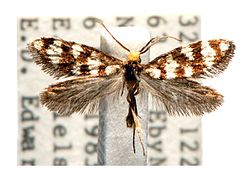| Lophocoronoidea Temporal range: | |
|---|---|
 | |
| Lophocorona commoni | |
| Scientific classification | |
| Domain: | Eukaryota |
| Kingdom: | Animalia |
| Phylum: | Arthropoda |
| Class: | Insecta |
| Order: | Lepidoptera |
| Clade: | Coelolepida |
| Infraorder: | Lophocoronina Common, 1990 |
| Superfamily: | Lophocoronoidea Common, 1973 |
| Family: | Lophocoronidae Common, 1973 |
| Genus: | Lophocorona Common, 1973 |
| Species | |
| |
| Diversity | |
| about 6 species | |
Lophocoronoidea is a superfamily of insects in the order Lepidoptera. There is a single extant genus, Lophocorona, in the family Lophocoronidae. These are small, primitive nocturnal moths restricted to Australia whose biology is largely unknown (Common, 1990; Kristensen and Nielsen, 1996; Kristensen, 1999).
Contents
A fossil genus Acanthocorona is known from the Burmese amber of Myanmar, dating to the early Cenomanian stage of the Late Cretaceous, approximately 99 million years ago. [1]